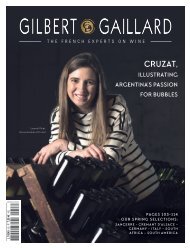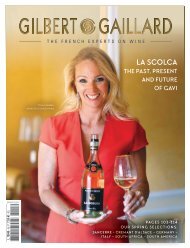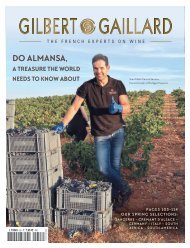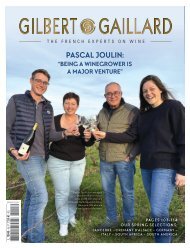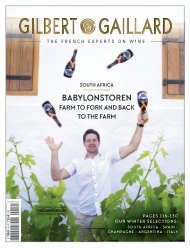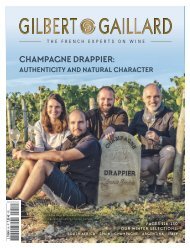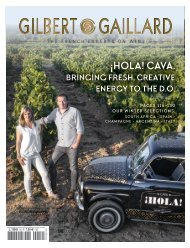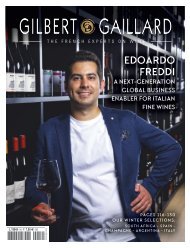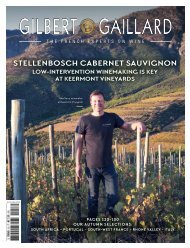FRA_GG_N45-WEB
The GILBERT & GAILLARD International Magazine : Make some room in your lounge for WINE REGIONS from around the world
The GILBERT & GAILLARD International Magazine :
Make some room in your lounge for WINE REGIONS from around the world
Create successful ePaper yourself
Turn your PDF publications into a flip-book with our unique Google optimized e-Paper software.
SOUTH AFRICA<br />
– SPIRITS –<br />
While Cape Brandy mirrors Cognac in its production<br />
techniques, however, it is proudly unique. ‘The difference<br />
lies in the base wines,’ says Danie Pretorius, master<br />
distiller at Oude Molen. ‘Cape Brandies are predominantly<br />
Colombard- and Chenin Blanc-based, while the main<br />
varietal in Cognac is Ugni Blanc, which yields a very<br />
neutral wine. Cognac generally gains its complexity from<br />
maturation, which is why they tend to use more new<br />
wood than we do in SA. Cape Brandies tend to be distilled<br />
and matured to preserve and enhance the complex fruit<br />
characteristics present in the base varieties. I believe that<br />
the sweet spot for a Cape Brandy is achieved at the point<br />
where these fresh fruit characteristics are complemented<br />
by maturation-derived aromas and flavours. This is usually<br />
achieved after 8-12 years of maturation.’<br />
The generally warmer and drier SA climate plays a role,<br />
too, resulting in base wines with slightly more alcohol than<br />
in Cognac (10 to 12% versus about 8%). ‘We use fuller,<br />
fruitier base wines in the production of our brandies,’ says<br />
Marlene Bester, distillery manager at Van Ryn’s, which<br />
is Distell’s flagship and another consistent winner of<br />
prestigious international awards. ‘As a result, our brandies<br />
are much more fruity and complex in character, and this<br />
you find on the nose as well as on the palate.’<br />
Lower humidity than in France can cause the alcoholic<br />
strength of the spirit to rise further during barrel maturation<br />
due to higher evaporation. ‘Maturation of the distillate is<br />
sped up, thus giving us a smooth, well-balanced product,’<br />
says De Bod. ‘We get the aged character a bit faster than<br />
producers in France or even Stellenbosch,’ says Andre<br />
Landman, winemaker at Die Mas van Kakamas, located in<br />
the hot, dry Northern Cape.<br />
Van Ryn’s distillery manager Marlene Bester<br />
MAJOR PLAYERS<br />
Just as Cognac is dominated by the likes of Martell,<br />
Hennessy, Rémy Martin and Courvoisier, SA brandy<br />
production is dominated by two companies: Distell (which<br />
produces several brands of blended brandies in addition to<br />
its flagship Van Ryn’s range of 10, 12, 15 and 20 Year Single<br />
Potstill Brandies) and KWV (whose core range consists of<br />
the 3 and 5 Year blended brandies and 10, 12, 15 and XXO<br />
20 Year Potstill Brandies, in addition to Imoya VSOP).<br />
However, Oude Molen has emerged as a third major player,<br />
Distell’s Van Ryn’s distillery is housed in a chateau-like complex in<br />
Vlottenburg, Stellenbosch<br />
AUTUMN 2021 GILBERT & GAILLARD - THE FRENCH EXPERTS ON WINE 107



